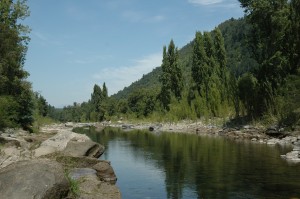 Let us first be as simple and well as Nature ourselves, dispel the clouds which hang over our brows, and take up a little life into our pores.
Let us first be as simple and well as Nature ourselves, dispel the clouds which hang over our brows, and take up a little life into our pores.
– Henry David Thoreau
Some regions in Chile are so special that they entice repeated visits. The natural beauty in Alto Bio Bio, especially the area surrounding the Rio Huequecura, and the creeks that feed into it, is so spectacular that our hearts have become forever attached to its lure.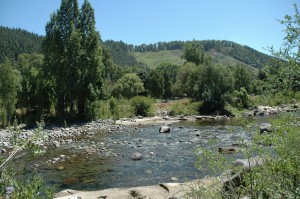
On a warm sunny Monday morning, we departed for Camping Huequecura, which is located further up the river from where we had last camped, and was a campground so thoughtfully constructed that both nature and human comforts were sympathetically accommodated. It had only taken a short tour of the grounds to confirm our plans to place a reservation for a site.
The Jeep was packed to the rooftop, and then some, with camp gear, food, backpacks and people. Our immediate group consisted of two young couples that we knew from the University of Concepcion, my mate, our human-in-training Ted, and myself. One other couple would join us later in the day. At first glance, it looked as if we were trying to defy the laws of physics, and force two objects to occupy the same space. Arms, legs, and bodies were so intermingled that it gave the appearance of a Pennsylvania Dutch funnel cake. For about three hours, such was our state of being. To our added discomfort, the Jeep was stuck behind a manure truck for the early part of the journey. Thankfully Chilean humor provided sufficient distraction.
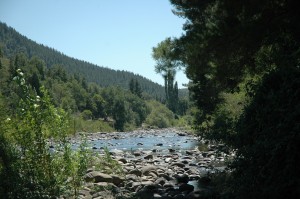 Of all the campgrounds that we have visited thus far, Camping Huequecura is premier in natural surroundings, cleanliness, facilities and services. We arrived to find kindling and logs stacked beside a campfire pit, with additional logs and a wheel barrel freely available nearby. A massive picnic table, mature trees and large, level areas to pitch tents comprised the perfect essentials for an enjoyable camping site.
Of all the campgrounds that we have visited thus far, Camping Huequecura is premier in natural surroundings, cleanliness, facilities and services. We arrived to find kindling and logs stacked beside a campfire pit, with additional logs and a wheel barrel freely available nearby. A massive picnic table, mature trees and large, level areas to pitch tents comprised the perfect essentials for an enjoyable camping site.
Potable water spigots were conveniently placed around the camp. A mini food stand not only sold food and other items, but also offered the use of its freezers to preserve meats for campers. Delicious, freshly baked pan amasado (raised breads) were available for purchase, and could be ordered for breakfast delivery.
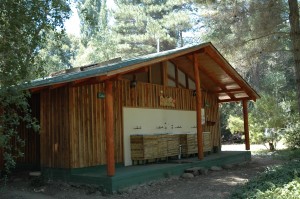 The bathrooms were very well maintained, offered hot showers, flushable toilets with paper, and regular sinks with liquid soap. Outside, there was a bank of real kitchen sinks for washing dishes, and even deep stationary sinks for clothes. Both bathroom and washing facilities were cleaned several times a day.
The bathrooms were very well maintained, offered hot showers, flushable toilets with paper, and regular sinks with liquid soap. Outside, there was a bank of real kitchen sinks for washing dishes, and even deep stationary sinks for clothes. Both bathroom and washing facilities were cleaned several times a day.
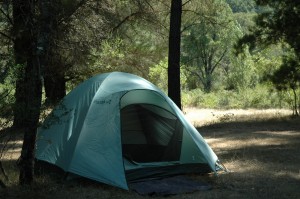 In spite of being filled to capacity, which was set at a maximum of 200, tranquility reigned. Campers respected the privacy of one another, and there was little noise to destroy the harmonious sounds of nature. Even though electricity was not offered at the sites, campers were considerate in not impeding the peace with the sounds of generators.
In spite of being filled to capacity, which was set at a maximum of 200, tranquility reigned. Campers respected the privacy of one another, and there was little noise to destroy the harmonious sounds of nature. Even though electricity was not offered at the sites, campers were considerate in not impeding the peace with the sounds of generators.
The owners have instilled a standard that most visiting from outside Chile will find very 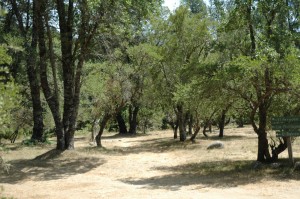 familiar and comforting. At the heart of all the rules for camping was respect for and the preservation of the natural environment. Fires were to be made only at designated areas, and were to be extinguished before retiring to bed. Other rules included: no littering; use trashcans and restrooms; use soap only at washing facilities; don´t remove or cause undo damage to trees and plants; no graffiti; only use designated swimming areas; preserve the cleanliness of the campgrounds and bathrooms; respect the privacy of others; and preserve the peace, with quiet hour set at 11pm. Phone numbers were also provided in case of an emergency.
familiar and comforting. At the heart of all the rules for camping was respect for and the preservation of the natural environment. Fires were to be made only at designated areas, and were to be extinguished before retiring to bed. Other rules included: no littering; use trashcans and restrooms; use soap only at washing facilities; don´t remove or cause undo damage to trees and plants; no graffiti; only use designated swimming areas; preserve the cleanliness of the campgrounds and bathrooms; respect the privacy of others; and preserve the peace, with quiet hour set at 11pm. Phone numbers were also provided in case of an emergency.
Many campgrounds that we have used in the past have required the suspension of sensibilities regarding cleanliness and adequacy. The lack of hygiene in restrooms and shower facilities is the usual culprit. Also, public educational campaigns, similar to the “Give a hoot, don´t pollute” that prevailed during the 1960-70s in the U.S., have not yet been initiated in Chile, So, it´s not uncommon to find trash everywhere.
Our reserved campsite was surprisingly clean, and we were able to get settled in quickly. The spaciousness of the site allowed for more than adequate space for privacy between tents. As everyone in our group was experienced in camping, setting up camp went very smoothly.
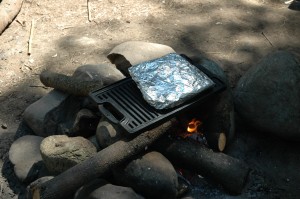 Without electricity, we usually prepared dinner while the sun still provides light. The guys would set the fire and position the surrounding stones so that the cast iron grill tray would be level across the flame. One the first night, Two pounds of pre-washed baby potatoes were wrapped in foil, and allowed to steam on top of the tray. When it was time to cook the meat, the foil package was moved to the edge of the fire. For the second day´s meal, pre-cooked beans with veggies were heated in a cast iron pan on top of the single burner camp stove. This was then moved that to two stones at the fire´s edge to continue cooking, while rice steamed in a pot on the burner.
Without electricity, we usually prepared dinner while the sun still provides light. The guys would set the fire and position the surrounding stones so that the cast iron grill tray would be level across the flame. One the first night, Two pounds of pre-washed baby potatoes were wrapped in foil, and allowed to steam on top of the tray. When it was time to cook the meat, the foil package was moved to the edge of the fire. For the second day´s meal, pre-cooked beans with veggies were heated in a cast iron pan on top of the single burner camp stove. This was then moved that to two stones at the fire´s edge to continue cooking, while rice steamed in a pot on the burner.
Even though our set-up was very basic, it only took a little pre-planning and some pre-camping preparation to ensure that we ate balanced meals that didn´t come out of a can. In addition to baking and preparing beans, which were frozen into quart-sized bags, and helped to keep the meat frozen in the cooler, pre-prepped curry dishes, soups, and stocks were also kept frozen until used. All fruits and vegetables were washed before packed, to conserve bottled water. Spring water bottles from previous camping excursions were recycled and filled with Brita-filtered water.
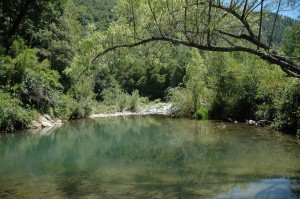 Camping Huequecura has two amazing swimming areas, one that close to the campgrounds (shown in photo) and has an area for children, and another that is part of a naturally deep section of river (unfortunately do not have a photo, didn´t want to leave my camara on the beach). Both have sandy beaches and are in very natural settings. Early in our first day, my mate and I braved the chilly waters of the smaller swimming area, called “pozo” in Spanish and means pool. Our trusted companion Teddy eagerly demonstrated his aquatic abilities to the entertainment of those reclining on the beach.
Camping Huequecura has two amazing swimming areas, one that close to the campgrounds (shown in photo) and has an area for children, and another that is part of a naturally deep section of river (unfortunately do not have a photo, didn´t want to leave my camara on the beach). Both have sandy beaches and are in very natural settings. Early in our first day, my mate and I braved the chilly waters of the smaller swimming area, called “pozo” in Spanish and means pool. Our trusted companion Teddy eagerly demonstrated his aquatic abilities to the entertainment of those reclining on the beach.
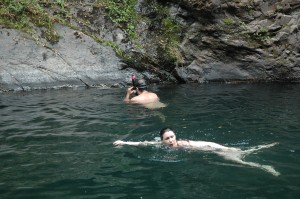 Camping Huequecura is not only a campground, but also offers a large expanse of park-like area for those who just want to picnic for the day. It features play areas for children, campfires made from tumbled river stone, picnic tables scattered under massive native tress, and a rustic path that leads from a vast picnic grounds, down to the larger pozo in the river. Every day, we enjoyed a late afternoon swim in its cool waters.
Camping Huequecura is not only a campground, but also offers a large expanse of park-like area for those who just want to picnic for the day. It features play areas for children, campfires made from tumbled river stone, picnic tables scattered under massive native tress, and a rustic path that leads from a vast picnic grounds, down to the larger pozo in the river. Every day, we enjoyed a late afternoon swim in its cool waters.
With encouragement from my fellow campers, I was able to put my fear of swimming where feet cannot touch bottom, and skimmed the water with a sidestroke to the other side. Our friend Jeny swam along side, in case I should panic halfway across. Although nervous, it felt good to overcome a long-held fear brought on by a near drowning.
There is something truly extraordinary to swimming in a river, especially one so clear, fresh and unpolluted as the mountain-fed Huequecura. When I reached the midway point, not only was I thrilled to be able to look down the river and feel part of it, but also experienced a feeling of liberation within and an embrace by nature.
Teddy, our aquatically-inclined canine, stood on the sandy beach, forlorn and crying 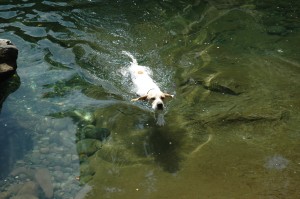 because he had been left behind. It only took a couple of calls before he dove into the water and swam to meet us. Although mostly cliff on that side of the river, Ted found a spot to climb upon and then stood looking down at all of us, who were perched on a boulder under the water´s surface.
because he had been left behind. It only took a couple of calls before he dove into the water and swam to meet us. Although mostly cliff on that side of the river, Ted found a spot to climb upon and then stood looking down at all of us, who were perched on a boulder under the water´s surface.
Teddy, too, had a fear to overcome. On a previous camping trip, someone had dropped him several feet above water, without knowing that a dog needs to enter horizontal and not vertical. Too far away to prevent what was taking place, my jaw fell, while my heart strangled my throat, as I watched Ted sink into the water. It wasn´t until Ted surfaced that I could breathe again.
So, while Teddy had climbed to the top of a rock jutting above the pozo of the river, he did not have the courage to jump back into the deep water. My husband, who was clinging to the rock´s edge, kept trying to coax Ted close enough to grasp his collar. Ted, however, stayed just beyond arm´s reach, frantic and crying, but to afraid to be caught.
I was still perched on the boulder, and was nervous about swimming back to the other side, and now had to contemplate pushing off to save my little boy. Swallowing my fear, and putting trust in God, I pushed off. As I approached, my husband grabbed my hand to pull me close and then push me up onto Ted´s rock. Needless to say, the fear was apparent on my face.
With a little soft coaxing, Ted approached close enough to apprehend. Although in protest, once placed in the water, Teddy swam a couple of circles before making his way to the other side. I, on the other hand, had to contemplate Socrates teachings about vertigo, and how it was man´s lack of faith in his self that caused the affliction. Such was the case with my fear of deep water. Eventually, I would have to start trusting myself and swim to the other side as well.
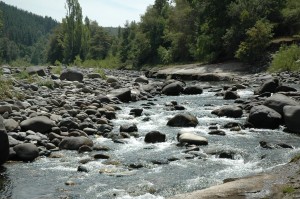 The next day, we decided to explore the river at the other end of Camping Huequecura. This time, the skills of a mountain goat were required to traipse along the water tumbled stones, boulders, and the basalt rock that had found its way to water after a long forgotten volcanic eruption. Were it not for the sounds of trucks hauling cut pine trees on the far shore, the river would have seemed like a land that time forgot.
The next day, we decided to explore the river at the other end of Camping Huequecura. This time, the skills of a mountain goat were required to traipse along the water tumbled stones, boulders, and the basalt rock that had found its way to water after a long forgotten volcanic eruption. Were it not for the sounds of trucks hauling cut pine trees on the far shore, the river would have seemed like a land that time forgot.
The bright sunlight danced on the surface of crystal-clear water. Even though there 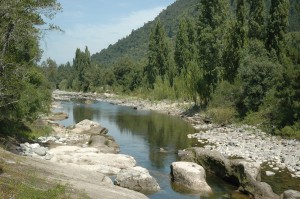 were areas more than two meters deep, the bottom could still be seen. Minnows, or were they possibly baby trout, darted back and forth in shallow areas, giving testament to the purity of the water.
were areas more than two meters deep, the bottom could still be seen. Minnows, or were they possibly baby trout, darted back and forth in shallow areas, giving testament to the purity of the water.
Although littered with bowling ball-sized granite rocks, smooth flows of basalt were partly exposed. Moss had taken root in areas where natural spring water trickled down to the basin of the river. While the basalt had originally flowed to the other side of the river, the coursing of water eventually eroded narrow baths through, thus dispelling the whole “rock-paper-scissors” thing for water proved that it too cuts rock.
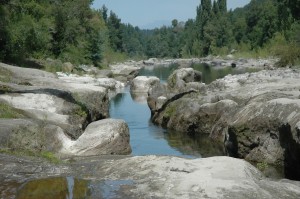 We happened upon one such area, which was deep enough to stand in chest-high water. Although chilling, we slipped in to bring comfort to skin that had been toasted by the mid-day sun. Teddy, who had already taken a few turns in the water, chose to find comfort atop our discarded outer clothing and shoes, with his head perch upon my camera.
We happened upon one such area, which was deep enough to stand in chest-high water. Although chilling, we slipped in to bring comfort to skin that had been toasted by the mid-day sun. Teddy, who had already taken a few turns in the water, chose to find comfort atop our discarded outer clothing and shoes, with his head perch upon my camera.
While my companions floated downstream to camp, Teddy and I made our way along, 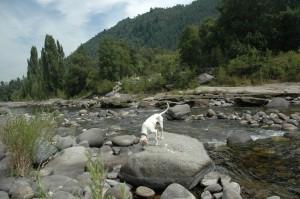 hopping from one stone to another, pausing periodically to digitally capture the beauty of the terrain.
hopping from one stone to another, pausing periodically to digitally capture the beauty of the terrain.
Upon arriving back at camp, we found a new camp fellow awaiting introduction to the group. Two of our friends, Oliverto and Jeny, had trekked to a different locale during the day, and happened upon a Chilean hawk, similar to the North American red-tail hawk, that was injured, unable to fly and starving. So, they brought the earth-bound fellow back to camp, in order to tend to his recuperation in Concepcion. As is Oliverto´s predilection towards strays in his care, the hawk was named Jon.
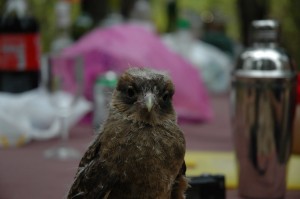 Jon must have been grounded for some time, given how thin he appeared. Oliverto sliced some thin pieces of ham, and patiently fed him one by one. His hunger was so great that it overcame his fear of human contact. Although Jon could have walked away at any time, he stood patiently on a tree stump near the picnic table. Even when another hawk flew to the tree above, calling to him, Jon stayed put. Whatever had befallen Jon, he was unable to join his kind.
Jon must have been grounded for some time, given how thin he appeared. Oliverto sliced some thin pieces of ham, and patiently fed him one by one. His hunger was so great that it overcame his fear of human contact. Although Jon could have walked away at any time, he stood patiently on a tree stump near the picnic table. Even when another hawk flew to the tree above, calling to him, Jon stayed put. Whatever had befallen Jon, he was unable to join his kind.
Everyone would stop periodically to feed him tidbits of meat or to trickle water into his 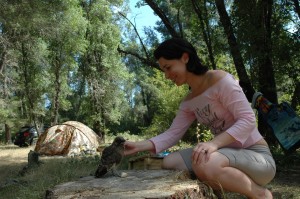 awaiting beak. We quickly learned that while he enjoyed the meat, especially the loma lisa, he would have no part of the fat, which he would grasp in his feet and push aside.
awaiting beak. We quickly learned that while he enjoyed the meat, especially the loma lisa, he would have no part of the fat, which he would grasp in his feet and push aside.
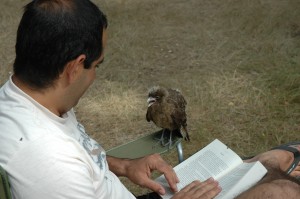 Jon became a good companion to Oliverto, and would rest perched on the arm of the camp chair while Oliverto read, or upon his shoulder as he strolled around the campsite. Although, in general, it is better not to tamper with the separation between wildlife and mankind, there are times when human intervention is a good thing. Without Oliverto´s compassion, Jon would never have had a chance to recuperate and survive.
Jon became a good companion to Oliverto, and would rest perched on the arm of the camp chair while Oliverto read, or upon his shoulder as he strolled around the campsite. Although, in general, it is better not to tamper with the separation between wildlife and mankind, there are times when human intervention is a good thing. Without Oliverto´s compassion, Jon would never have had a chance to recuperate and survive.
Our time at Camping Huequecura was so special that we extended our stay for one more full day, which really turned into two more days and one night. In truth, no one wanted to leave the natural setting, the tranquility, the river and creeks, and the gentleness of simple communal living.
The river near the picnic grounds was not only deep in the middle and to the far banks, but also provided a long expanse suitable for Oliverto´s inflatable boat to venture upon. On what became our unanimously elected “bonus day,” the men took the boat from the point of the smaller swimming area, to begin their exploration of the river as far as the boat could travel. In reality, they had wanted to give their fishing gear a little water time. Although only the rocks were biting during their ride down, and many lures were lost, they had a grand adventure.
Land-bounded, the remainder our group, as well as Teddy, walked to the large pozo to see if we could spot the boat. It turned out that the pozo was where their rafting ride would end, and ultimately we joined in one last swim in the river´s refreshing waters.
This time, both Teddy and I were a little braver. On the swim back from the far bank, one young boy, probably about 10 or 12 years old, raced Teddy back to the sandy shore. Everyone cheered both Teddy and the boy on as they swam their hardest, neck-to-neck in the water. Either tiring or wanted to watch Teddy, the boy stopped short of the shore, while everyone shouted hurray for my furry-four-legged youngster. Later, I could hear the boy exclaiming amazement about how fast Teddy could swim. For Teddy´s part, he was to retain his glory and recognition throughout the rest of our stay, with other campers stopping to pet and lavish praise upon him.
At the end of our swim, Oliverto treated the ladies to a leisurely raft ride back to the smaller pool. I was thrilled to see the cliff of sedimentary layers and basalt. The rock told the history of the region´s birth and transitions. At the end of our ride, we hopped rocks back to the small pool, and made our way back to the campsite, tired but immensely satisfied.
The next day, and sadly our last, the men were stilling itching for fishing, so we drove to 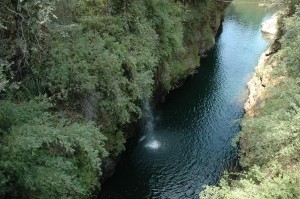 the bridge, Pte. Huequecura, which had been passed on the way in, to see if a good place to drop lines could be found. Although the bridge itself was too high to warrant fishing, we followed a somewhat hidden path, with bamboo trees as our handrails, down to a wide, flat cliff at the river´s edge. Sedimentary rock formed a natural ladder into the river. In the near distance, spring water cascaded down to the water´s surface.
the bridge, Pte. Huequecura, which had been passed on the way in, to see if a good place to drop lines could be found. Although the bridge itself was too high to warrant fishing, we followed a somewhat hidden path, with bamboo trees as our handrails, down to a wide, flat cliff at the river´s edge. Sedimentary rock formed a natural ladder into the river. In the near distance, spring water cascaded down to the water´s surface.
The cliffs overhanging the river proved to be perfect for diving 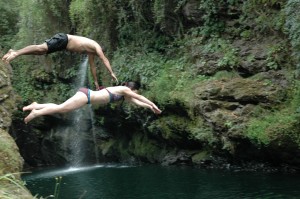 competitions, and demonstration of verve and form. As the waters had previously been explored, and it was fairly easy to see the rocks under surface, there was less concern for accidents.
competitions, and demonstration of verve and form. As the waters had previously been explored, and it was fairly easy to see the rocks under surface, there was less concern for accidents.
As the afternoon began to wan, we left the hidden grotto to explore one last “swimming hole.” Located across from the school lies an open expanse of river, with a rocky, pebbly shore and a striking, towering cliff on the other side. At one end of this swimming area was a small rapid through which swimmers tried to pass on stomachs, backs, or behinds. More accessible, the locale seemed popular with local families.
With the evening approaching, we loaded ourselves into the cars, and headed back to 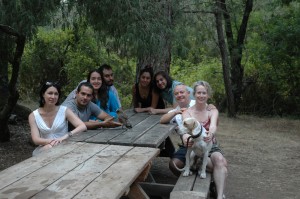 camp. It was time to make the sad and dreaded effort of packing up the gear, to leave behind the majestic paradise of Huequecura. Even the heavens shed a few tears with us as the task was applied.
camp. It was time to make the sad and dreaded effort of packing up the gear, to leave behind the majestic paradise of Huequecura. Even the heavens shed a few tears with us as the task was applied.
Camping Huequecura is by reservation only, and can be contacted at 98843914. They also have a page on Facebook. Camping, from Monday to Thursday is CLP$3.500 (about USD $7.00) per adult, and CLP $2.500 (USD $5.00) for children (5-15 yrs.) and seniors (age 65+). Friday to Sunday, as well as holidays, the price per day for camping is CLP $4.500 (~ USD $9.00) for adults and CLP $3.500 (~USD $7.00) for children and seniors.
One-day picnics are: Monday-Friday, CLP $1.200 (~USD $2.40) for adults and children; Saturday, Sunday, holidays, CLP $2.500 (~USD $5) for adults and CLP $2.000 (~USD $4.00) for children and seniors.
Camping Huequecura is closed for the season after March 31. During the month of March, they offer a 30% discount.
Nice article. Thank you. Our desire is to maintain and improve what we have to offer campers and outdoor enthusiasts. Glad to hear your stay was pleasant.
Cool beans !! Thank you. If you have any suggestions which could be beneficial to our guests. We are open to ideas. Take care